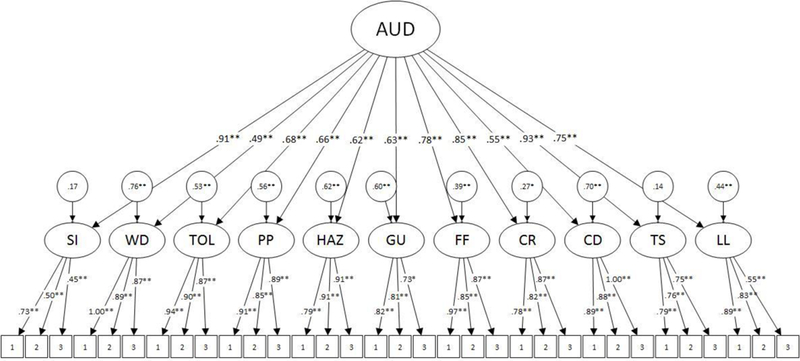Figure 1.

Higher-Order Confirmatory Factor Analysis of the 33 Alcohol Use Disorder Symptom Indicators. This figure demonstrates the higher-order model specified to demonstrate the unidimensionality of the 33 alcohol use disorder symptom indicators chosen from the IRT-models to indicate low, medium, and high severity. Table 2 lists full descriptions of the 33 items ranging from low to high severity. All estimates are standardized. Estimator = WLSMV. χ2 [551] = 2959.35,p < .0001; RMSEA = 0.09. **p < .001, *p < .01. LL = “Alcohol is taken in larger amounts or over longer periods than was intended;” TS = “A great deal of time is spent in activities necessary to obtain alcohol, use alcohol, or recover from its effects;” CD = “There is a persistent desire or unsuccessful efforts to cut down or control alcohol use;” CR = “Craving, or a strong desire or urge to use alcohol;” FF = “Recurrent alcohol use resulting in a failure to fulfill major role obligations at work, school, or home;” GU = “Important social, occupational, or recreational activities given up or reduced because of alcohol use;” HAZ = “Recurrent alcohol use in situations in which it is physically hazardous.” PP = “Alcohol use is continued despite knowledge of having a persistent or recurrent physical or psychological problem that is likely to have been caused or exacerbated by alcohol.” TOL = “Tolerance, as defined by either of the following: (a) A need for markedly increased amounts of alcohol to achieve intoxication or desired effect (b) A markedly diminished effect with continued use of the same amount of alcohol.” WD = “Withdrawal, as manifested by either of the following: (a) The characteristic withdrawal syndrome for alcohol, (b) Alcohol (or a closely related substance, such as benzodiazepine) is taken to relieve or avoid withdrawal symptoms.” SI = “Continued alcohol use despite having persistent or recurrent social or interpersonal problems caused or exacerbated by the effects of alcohol.”
